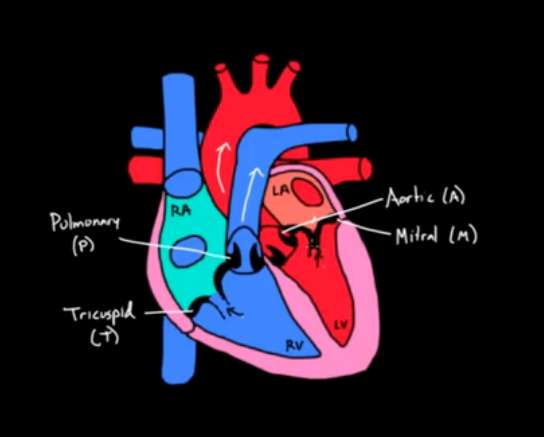And the same thing happens on this side.
這里也是一樣的
Let's imagine you have some backwards flow of blood by accident,
假設這里血液出現了逆流
meaning that it's going in the wrong direction.
方向又出錯了
Well, then these valves are going to close down.
這時瓣膜是關閉的
So the white arrows represent the correct flow of blood,
重申一下,白色的方向是正確的
and the black arrows represent the incorrect flow of blood.
黑色的血液流動方向是錯誤的
So these valves shut down like that.
這時瓣膜應該是關閉的
So now you can see how the valves, the aortic and pulmonary valve,
現在大家看到,三尖瓣和二尖瓣打開的時候
are actually closed when the mitral and tricuspid valve are open.
主動脈瓣和肺動脈瓣是關閉的
So what happens after this?
之后又會怎樣呢?
So now our ventricles are full of blood, right?
心室充滿血液之后會怎樣呢?

They're full of blood.
現在心室充滿血液
And let's say they squeeze down, and they jettison all the blood into those arteries.
假設心室將血液擠壓出去,進入動脈
Well, now you're going to have-- this is actually going to close down.
那么這里瓣膜是關閉的
Let's say this arrow flips around.
假設箭頭轉向
These arrows become white,because the direction of flow is going to be in the direction we want it.
這里箭頭變成白色的了,因為現在方向是正確的
It's going to go this way and this way
流動方向是這樣的
And to allow that, of course, I need to show you that these open up.
那么這里瓣膜要打開
And they allow the blood to go the way that we want it to go,
使血液通過
so now blood is going to flow through those two valves.
現在血液通過主動脈瓣和肺動脈瓣了
But similar to before, you could have some backflow here. Right?
同樣的,這兩個地方血液可能回流
You could have backflow here.
可能出現逆流的情況
And you can have backflow here.
這里也可能出現逆流
So you can imagine now, let's say you have a little bit of backflow that
那么大家看,假設這里血液逆流
wants to go this way, which is the wrong direction.
這樣的流動方向是錯誤的
Right? Well, then these valves are going to close up.
那么瓣膜應該關閉
They're going to say, no, you can't go that way.
瓣膜要阻止血液逆流
They're going to close right up, and they're going to not allow blood to go that way.
這里的瓣膜要關閉,不能讓血液回流
So this is going to happen on both sides, both ventricles.
兩邊的心室都是一樣的情況
And the valves shut.
這時房室之間的瓣膜就關閉了
And so basically the backflow of blood is not allowed, because the valves keep shutting.
瓣膜關閉,這樣血液就不會回流了
And when the valves snap shut-- so for example, right now
瓣膜關閉
the tricuspid valve and the mitral valve snapped shut.
比方說這里,三尖瓣和二尖瓣關閉
Well, that makes a noise.
是有聲音的
So when T and M snap shut, that makes a noise that we call lub.
三尖瓣T和二尖瓣M關閉時,產生的聲音就是前述的“咚”
That's that first noise, that first heart sound.
也就是第一個心音
In fact, sometimes people don't even call it lub dub.
專業形容心跳聲音不會用“咚噠”
They say, well, it's the first heart sound.
而是說,第一個心音
And to make that even shorter, sometimes people call that S1.
為了描述簡便,也叫S1
So if you hear S1, you know they're talking about that same exact thing.
如果有人說S1,你就知道,這是說的第一個心音
And this dub is called the second heart sound.
而“噠”就是第二個心音
And, no surprise, just as before, if that's S1, this is S2.
同理,第一聲是S1,那么這就是S2
So you'll hear S1 when the tricuspid and mitral valve snap shut.
三尖瓣和二尖瓣關閉時,聲音是S1











